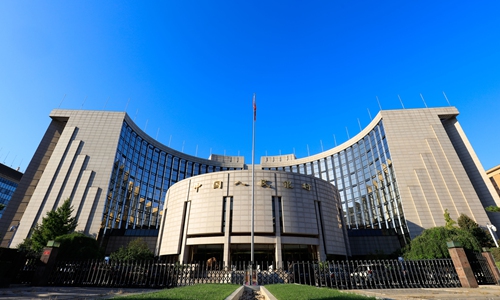HOME >> SOURCE
China's new lending benchmark LPR unchanged in January
By Xie Jun Source:Global Times Published: 2020/1/20 22:03:42
New lending benchmark LPR unchanged in January

A view of the PBC's headquarters in Beijing Photo: cnsphoto
China's new lending benchmark, the loan prime rate (LPR), has been unchanged in January, although experts predicted that the government will guide the LPR lower later this year to cut corporate borrowing costs and provide stimulus as the country's GDP growth slows to the lowest in years.They also suggested that the government should speed up reform of the capital markets so that the latter can shoulder more responsibility of medium- and long-term financing, thus creating a competitive financing mechanism that will push banks to lower their lending rates.
China's one-year LPR now stands at 4.15 percent while the five-year LPR is at 4.8 percent, both figures unchanged from December, according to a statement published on Monday by the People's Bank of China (PBC), China's central bank.
It is the second month that the LPR rate remained unaltered. In November, the PBC lowered the one- and five-year LPRs by 5 basis points (bps).
The PBC has reformed the LPR mechanism to better reflect market changes in its latest move to lower borrowing costs to support the real economy. Under the revamped mechanism, LPRs, which are released on the 20th of each month, are based on open market operating rates and the Medium-term Lending Facility (MLF) rate.
The PBC has kept the MLF rate unchanged since cutting it by 5 bps in early November.
"Right now, the effects of the MLF cut, which might in turn drive down the LPR, would be limited in terms of reducing the financing costs of domestic companies, because domestic financial institutions are yet to convert existing loans to the LPR as the new base," Chen Ji, an economist of the Bank of Communications, told the Global Times via a statement.
The base shift is expected to start in March and should be completed before the end of August, the PBC noted earlier.
"When such a shift takes place in 2020, it would become an important window of opportunity for the government to lower interest rates," Chen said, indicating that the government might guide the LPR lower via interest rate cuts later this year.
Experts also noted that difficulties faced by domestic banks are curbing their willingness to lower lending rates.
"Domestic banks are cautious about lending over fears of potential non-performing loans amid the general economic slowdown," Xi Junyang, a professor at the Shanghai University of Finance and Economics, told the Global Times on Monday.
Dong Dengxin, director of the Finance and Securities Institute at Wuhan University of Science and Technology, said that domestic banks are seeing rising debt costs because of the loss of deposits, as capital is shifting toward other channels like the stock markets. The situation is making banks more cautious about their lending scales.
The government already injected liquidity into the market via a reserve requirement ratio cut in January and several reverse repurchase agreements.
"In theory those measures would boost banks' willingness to lend. In reality, they are not enough to dispel the pressure and worries of domestic banks," Dong told the Global Times.
Dong said that a competitive financing mechanism should be formed in China, saying that capital markets should play a more important role in medium- and long-term financing, which will put pressure on banks to offer more competitive lending rates to their customers.
Posted in: MARKETS,BIZ FOCUS